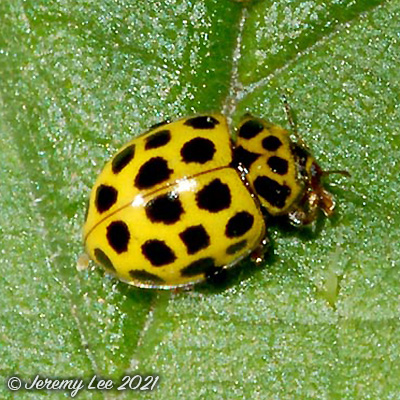
 |
|
Scientific Classifications explained » Amphibians » Ants » Aphids » Bees » Beetles » Birds » Bugs » Butterflies » Caterpillars » Damselflies » Dragonflies » Earwigs » Flies » Frog/Leafhoppers » Fungi » Galls » Grasshoppers » Harvestmen » Hoverflies » Lacewings » Ladybirds » Leaf Mines » Lichens » Mammals » Millipedes » Mosses » Moths » Sawflies » Slugs » Snails » Spiders » Trees & Shrubs » Wasps » Wild Flowers » Woodlice » Postboxes |
UK Nature > Ladybirds > Psyllobora vigintiduopunctata

Scientific Name: Psyllobora vigintiduopunctata Common Name: 22-Spot Ladybird Psyllobora vigintiduopunctata, more commonly known as the 22-spot ladybird, is a small (3-4mm in length) ladybird, the brightest of the yellow British ladybirds. They always have 22 spots, which are rarely fused. It has no central black line and appears more circular in shape than the 14-spot. There are two colour varieties, one where the pronotum is yellow (as shown in my photograph), the other where it is white. Unusually amongst ladybirds, it eats mildew, grazing from the soil surface or from low herbage, especially hogweed. Sweeping dense ground vegetation is the most effective method to find it, but turning over hogweed leaves is also a reliable method. Adults can be seen from April to August and is fairly common throughout England, less so in Wales and Scotland. |
|

https://www.uknature.co.uk is a website dedicated to showing the immense diversity of UK nature and wildlife. Our vast range of habitats, from lowland arable to snow covered mountains, from storm-ravaged coastlines to peaceful inland freshwater lakes and rivers, from dry, sandy heaths to deciduous and coniferous forests, all these habitats contribute to the abundance of UK nature. We have wild birds in huge numbers either residing or visiting our shores (597 recorded species as at July 2013) and we must also not forget the humble back garden with its grass lawns, flower beds filled with nectar rich flowers, shrubs and trees, all designed to attract huge numbers of insects such as bees, moths, butterflies and hoverflies; and finally the small ponds which provide safe havens for frogs, toads, newts and even slow worms and grass snakes. www.uknature.co.uk is the showcase for my personal passion, photographing uknature in all its glory. I sincerely hope you all enjoy the fruits of my labours. This site and all images contained therein is © Jeremy Lee 2004 - 2025. All Rights Reserved. Site design by Jeremy Lee. Site development & IT Support by Stuart Lee. |